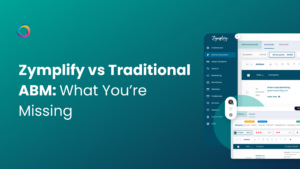Every lead is valuable, but not all leads are created equal. Some prospects are in the early stages of researching solutions, while others are ready to make a purchase. The challenge for businesses lies in identifying which leads to prioritise and how to engage them effectively.
This is where intent intensity comes in. By analysing intent signals, such as website visits, content downloads, and competitor comparisons, you can determine which prospects are showing strong buying intent and focus your efforts where they’ll have the greatest impact.
Understanding Intent Intensity
Intent intensity measures the strength of a prospect’s buying signals. High-intensity leads display clear behaviours that indicate they are actively in-market, such as engaging with multiple touchpoints, researching specific solutions, or interacting heavily with your competitors.
Lower-intensity leads may show general interest but lack the behaviours that suggest immediate readiness to purchase. Segmenting leads by intent intensity allows businesses to allocate resources more effectively, prioritising those most likely to convert while nurturing those still in earlier stages.

Key Metrics for Assessing Intent Intensity
Understanding which leads to prioritise requires clear metrics that reveal a prospect’s level of intent. These metrics provide actionable insights that enable your team to focus their efforts effectively.
To prioritise leads effectively, focus on these key intent metrics:
1. Engagement Across Multiple Channels
Leads who interact with your website, open your emails, and engage with your ads demonstrate higher intent intensity than those engaging with only a single channel.
2. Content Interaction Depth
Downloading in-depth resources like case studies or attending webinars indicates a deeper interest in your solution compared to casual blog readers.
3. Competitive Comparisons
Leads researching your competitors on platforms like G2 or downloading competitor whitepapers are showing strong buying intent.
4. Frequency and Recency of Interactions
Leads who engage repeatedly and recently are more likely to be in-market compared to those with sporadic or outdated activity.
How to Segment Leads by Intent Intensity
Effective lead prioritisation requires a clearly defined segmentation process. By categorising prospects based on their level of intent, businesses can focus on high-value opportunities while nurturing early-stage leads. This segmentation ensures that your sales and marketing efforts align with the readiness of each lead.
Identify Key Intent Signals
Start by defining which intent signals matter most to your business. These might include website visits, form submissions, or specific content interactions.
Assign Scoring Weights to Signals
Create a scoring system that assigns higher weights to behaviours that indicate stronger intent, such as competitor comparisons or event participation.
Categorise Leads into Tiers
Group leads into tiers based on their total intent score:
- High-Intent Leads: Ready for immediate outreach by sales.
- Medium-Intent Leads: Ideal for nurturing campaigns to move them further along the funnel.
- Low-Intent Leads: Early-stage prospects who may benefit from general awareness efforts.
Automate the Process
Use marketing automation tools to score and categorise leads in real time, ensuring your team can act quickly on high-priority accounts.
The Role of Intent Data in Prioritisation
Intent data takes the guesswork out of lead prioritisation by providing a clear view of which prospects are actively researching solutions. Buyer Intent Activation and Intelligence platforms like Zymplify consolidate intent signals from multiple sources, such as first-party website data, second-party competitor insights, and third-party topic trends, giving you a comprehensive picture of buyer behaviour.
With this data, businesses can:
- Focus on High-Value Opportunities: Spend less time on cold leads and more time on prospects who are ready to buy.
- Personalise Outreach: Use intent insights to craft tailored messaging that resonates with a prospect’s specific needs.
- Increase Efficiency: Automate lead scoring and prioritisation to streamline workflows and improve team productivity.
Maximise Sales and Marketing Success with Intent Intensity
Lead prioritisation is about working smarter, not harder. By focusing on intent intensity, businesses can identify their most promising prospects, optimise their resources, and drive higher conversion rates.
Ready to see how intent data can transform your lead prioritisation strategy? Book a demo with Zymplify today and discover how we can help you identify, prioritise, and engage high-intent leads with precision.




